How to make Water Kefir! A happy, bubbly, fruit-infused sparkling water, that is packed full of healthy probiotics that will energize the body and support the gut.
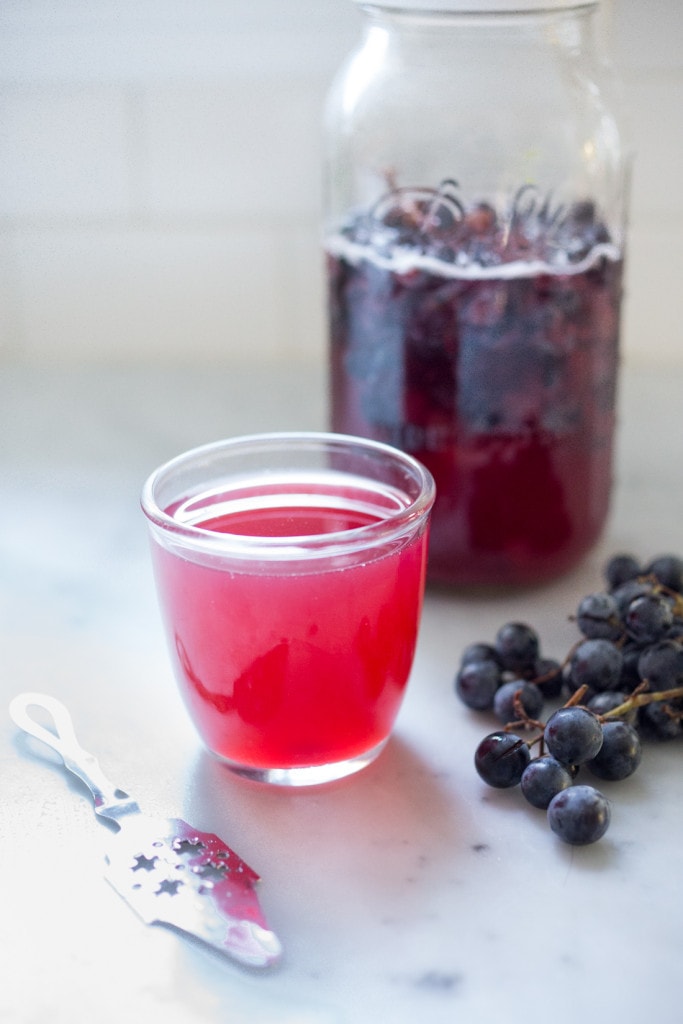
I want to introduce you to a happy, bubbly probiotic drink called water kefir!
This delicious, effervescent, fruit-infused water si full of healthy probiotics that support a healthy, diverse microbiome, clears the skin, and energizes the whole body. It’s similar to kombucha but without the caffeine!
The best part is that it is easy to make at home! I hadn’t heard of water kefir until a friend of mine, Bee (from H is For Love), introduced it to me a few years ago, and since then, I’ve been crazy, head-over-heels in love with it. We’ve been making batches and batches of this refreshing, healthy beverage all summer long.
But First, What is Water kefir?
- Fermented, fruit-infused water, similar to kombucha in that it’s slightly fermented and effervescent-but water kefir is fermented with live water kefir grains, which are a yeast-bacteria that believed to originate from the pad of a cactus plant in Mexico.
- Water kefir is completely different from Milk kefir. Not only is this a dairy-free probiotic, it’s gluten-free.
- Water Kefir Grains are “fed” with sugar and actually metabolize (consume) the sugar, making the final drink very low in sugar!
Watch How to Make Water Kefir
How long does it take to make kefir water?
It takes about 3-4 days to make Kefir Water, with only 15 minutes of hands-on time!
Water Kefir Ingredients
- Water Kefir Grains -This is the starter culture that ferments the water. Soft and gelatinous “grains” (a combination of yeast and bacteria) believed to originate from Mexico where they were found attached to the Ountia cactus (prickly pear) thriving from the cactus’s sugary water. Purchase Water kefir grains in the refrigerated section of your health food store, or purchase online, and read the package directions to fully activate them before starting! This may take a week- or may come already activated.
- Sugar – Types of sugar include organic cane sugar, coconut sugar, jaggery, molasses, sucanat, brown sugar, raw sugar, turbinado, piloncillo (evaporated sugar cane juice in a cone-shape found in Mexican markets). White sugar is very mineral deficient so I try not use it- or only in a pinch.
- Fruit – fresh fruit and berries are ideal here. Juicy ripe stone fruits ( plums, peaches, nectarines, cherries, etc.) fresh berries (strawberries, huckleberries, blackberries, blueberries, etc.) Pineapple, apples, pears, or Frozen fruit, or fruit juice will work too.
- Water- Tap water or well water is generally best when making water kefir- or use “still” mineral water. Hard water is better than soft water here! Filtered water, reverse osmosis water, or soft water or highly chlorinated water can actually inhibit fermentation. Distilled water tends to lack minerals that feed the kefir grains.
- Lemon Slices – to prevent kahm yeast.
- Unsufulerd Prunes- optional, to boost fermentation- or sub-dried figs, unsulfered apricots, or other dried fruit.
- 2-quart mason jars ( you will need 2-3 jars)
- A strainer
- A kitchen towel
How to make Water Kefir
- STEP ONE: Fill two, 2-quart mason jars to the halfway mark.
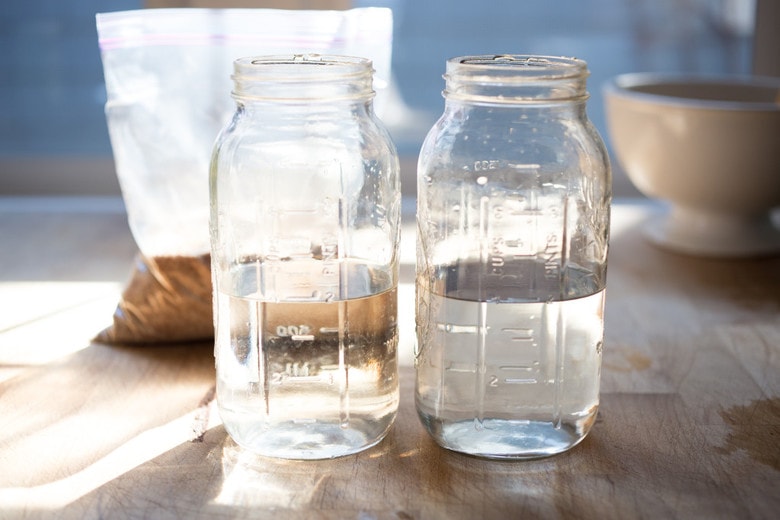
STEP TWO. To the water, mix in ¼ cup of organic cane sugar into each jar. I highly recommend making the “sugar mixture” in the recipe notes which contains more minerals (than white sugar) which keep the grains happy and help with fermentation.
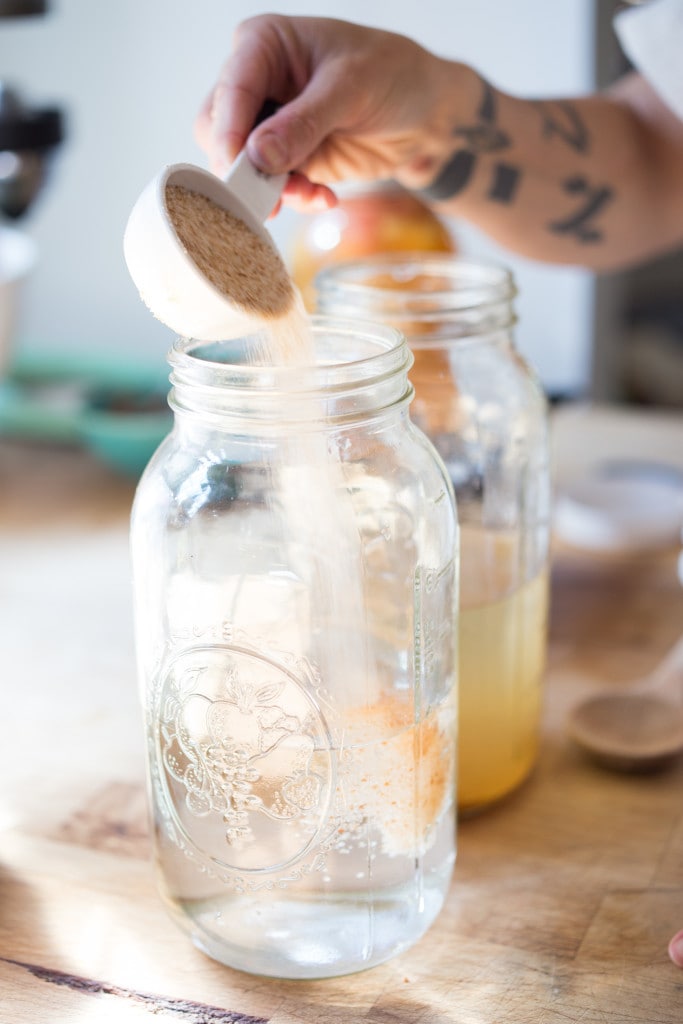
Now before you start thinking (like I did) that there is so much sugar in this, and how it must be so high in calories, remember, the kefir grains metabolize the sugar, which means they basically “eat” the sugar, (this is what feeds them) taking it out of the water. Once it’s done doing its thing, the water is only very mildly sweet, which I find completely and utterly fascinating!
Where does the sugar go?
From Yeemos: “Kefir grains are an amazing symbiotic matrix of bacteria and yeast that work together to feed off the natural sugars (and sometimes proteins and fats too, especially in the case of milk kefir) found present in the sugar-water and dried fruits. The yeast and bacteria cooperate, making the nutrients that are inaccessible to one digested into accessible nutrients for the other. Yeasts break down the simple sugars like glucose and fructose, turning them into ethanol and acetic acid. Lactic and acid-producing bacteria (such as lactobacilli) convert sugars (such as sucrose) and complex carbohydrates (starches, etc) into simpler sugars and lactic acid. Lactic and acetic acids naturally preserve as well as stave off harmful foreign bacteria. The result is a drink that has had much of the sugar converted to simpler sugars, lactic and acetic acids, carbon dioxide and ethanol. It also contains millions of probiotics and is more nutritious in some regards because of the more bio-available and digestible nutrients from the sugars and dried fruits including an increase in vitamin C and many B vitamins.” From Yemoos
Stir the sugar into the water with a wood spoon until dissolved.
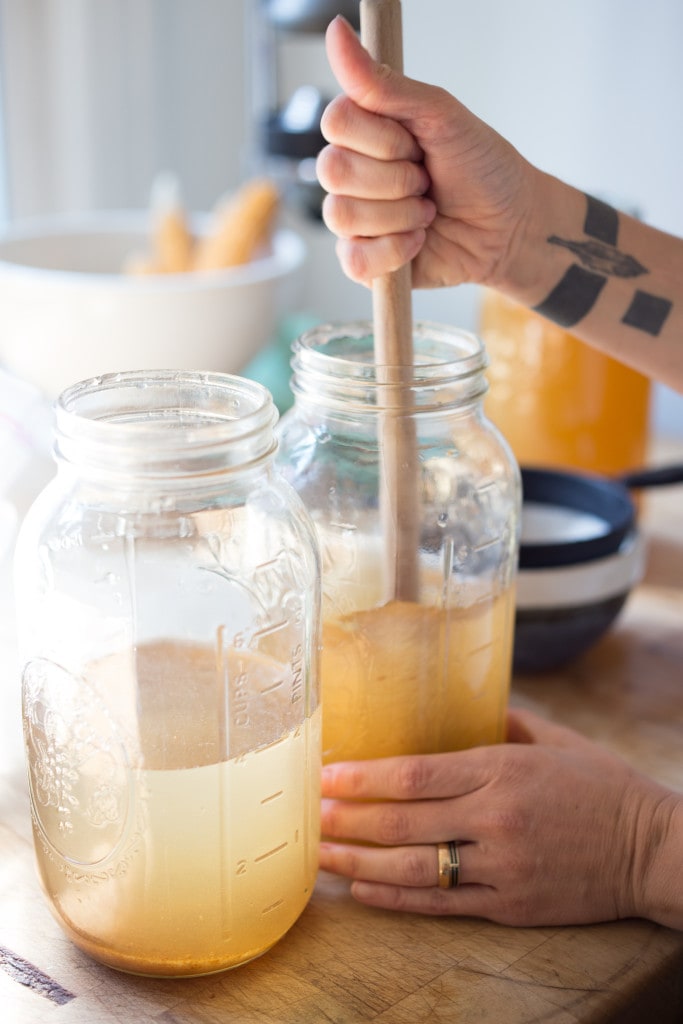
STEP THREE: Add 1/4 cup water kefir grains to each jar. Gently stir.
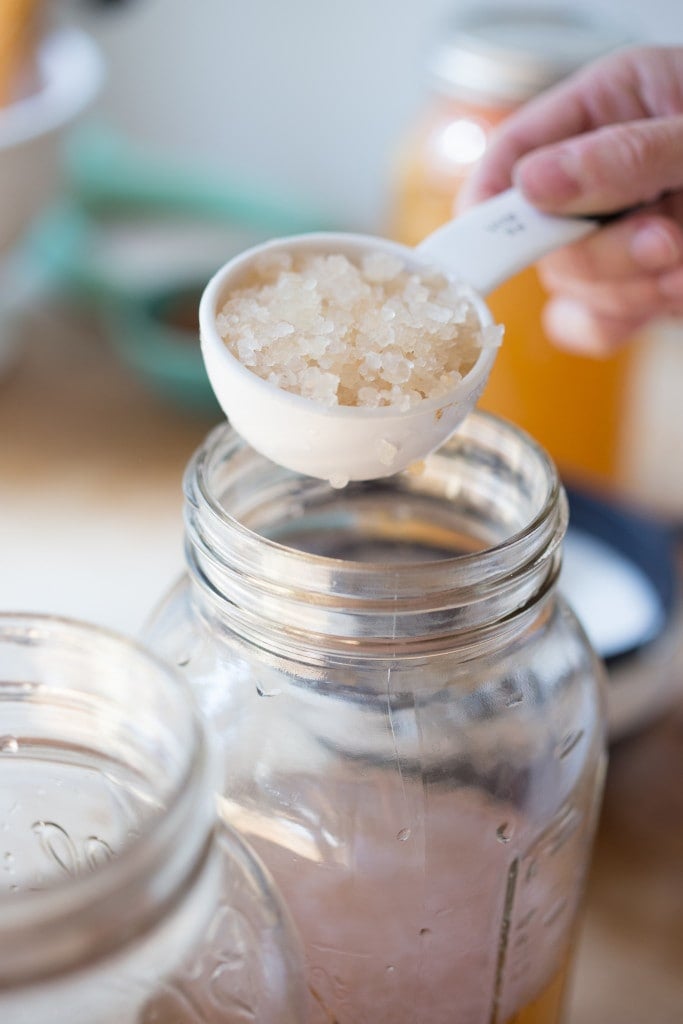
STEP FOUR: Add a big slice of lemon to each jar. Now if you are allergic to lemons, sub orange, lime or even grapefruit. The acidity here helps prevent the growth of Kahm yeast – a harmless yeast but one that could affect the taste.
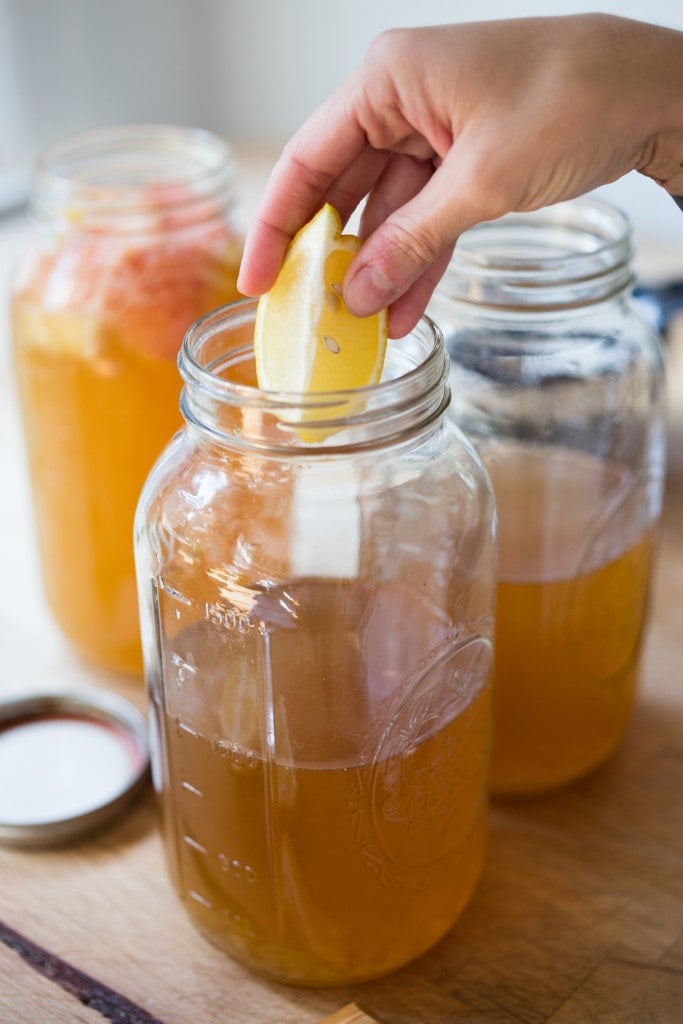
STEP FIVE: Add one prune to each jar. These seem to also boost fermentation. They are not imperative, but definitely add if you have them on hand. A dried fig, or a few raisins would work too.
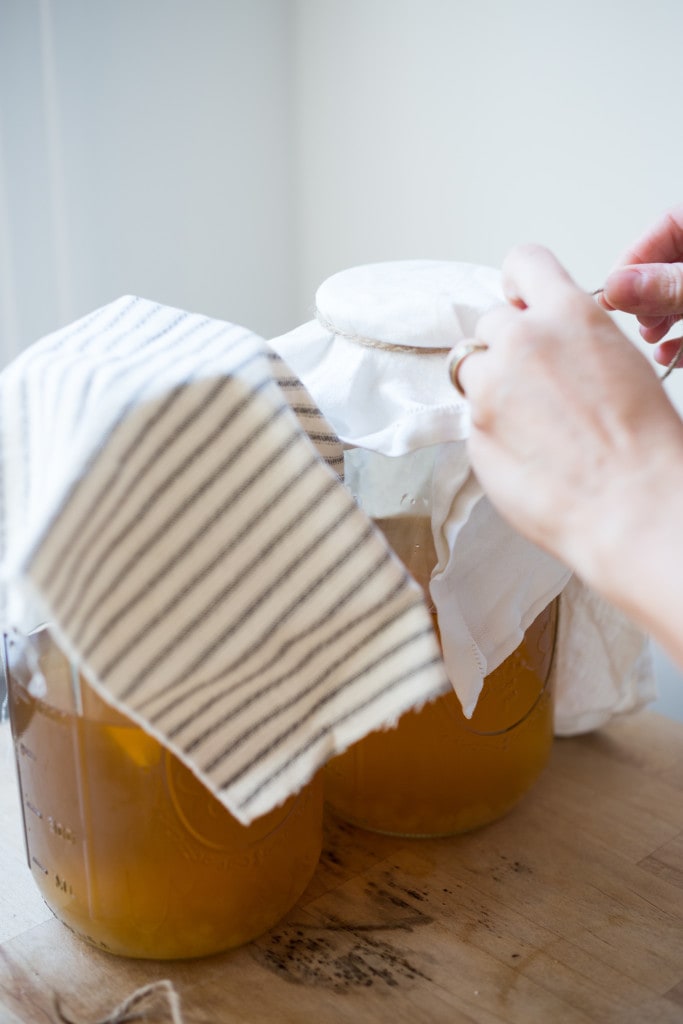
STEP SIX: Cover with a thin kitchen towel. It needs to breathe, but you want to prevent little fruit flies from getting in and seal it with twine or a rubber band. You could also top it with a coffee filter.
STEP SEVEN: The First Ferment. Let the jars sit on the kitchen counter at room temperature for 2-3 days. Two days if it’s warm out (in the summer), 3-4 days if it’s cold. Right now in fall, I’m leaving it out for 3 days.
Check for sweetness. After 2 or 3 days your kefir water should have fermented slightly – and you can check this by tasting it. If it tastes very sweet, then the sugar has not been metabolized and you need to ferment it longer. The longer it goes, the tangier it will taste and the less sweet it will get. You want it to taste balanced- just subtly sweet with a little bit of tangy. Find your own balance. If you taste no tanginess, it may not have fermented, a sign the kefir grains may not be healthy, active or alive.
TIP: Tangy or sour flavors tell you it has fermented. If it is not getting tangy or sour after 3-4 days, then your kefir grains may not be alive or active.
STEP EIGHT: Create your flavor. Place 1 – 1 1/2 cups fresh fruit in one clean 2-quart jar– like fresh berries, peaches, apricots, pineapple, plums, concord grapes, apples or pears. You can also add fresh herbs. Then strain both jars of the fermenting kefir into the third clean jar with the fresh fruit in it, straining out the kefir grains (set these aside) filling the jar to a ½ inch from the top. (Save the extra fermented water to store the grains in and place them in the fridge with 1 tablespoon sugar. Add more water to cover.)
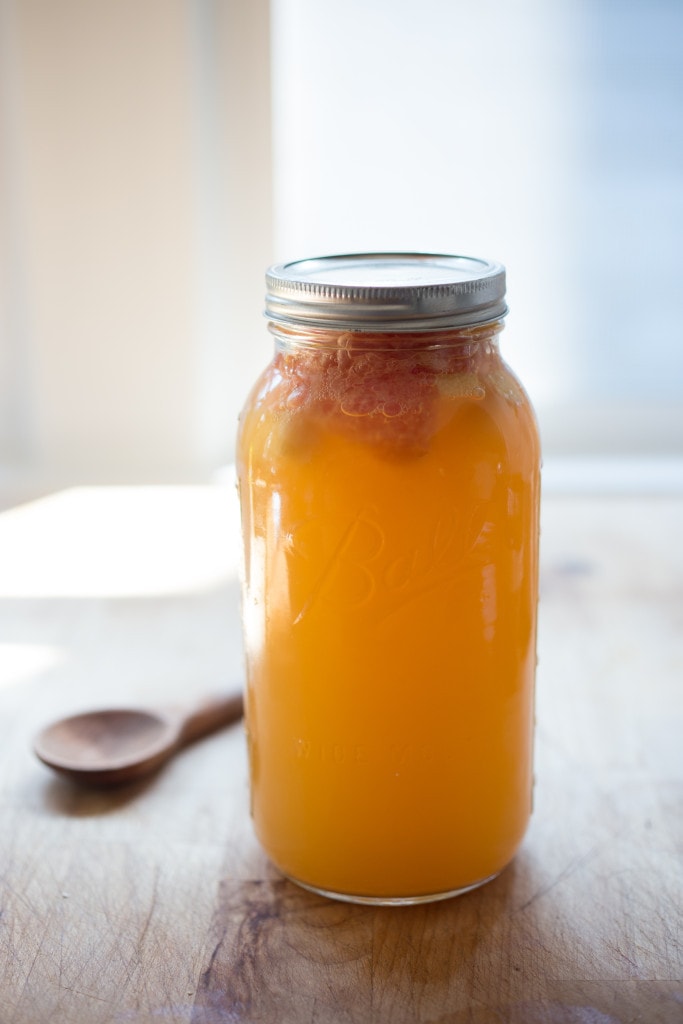
STEP NINE: The Second ferment. Once the fruit is added, cover tightly with a lid, and leave on the counter for another 24 hours. Your kefir should start bubbling. During the 2nd Ferment, the water kefir is creating gas and building pressure, which you want it to do – this makes it nice and bubbly, but with the metal lids, you must let out some of the pressure, “burping it” every 6-12 hours or so (depending on the temperature in your kitchen) so the lid doesn’t explode open (yes this happened to me). With a plastic lid, it stays on fine, and the air can escape. If using a metal lid, just screw the top on loosely until you feel the first resistance- this will allow some air to escape.
WARNING: These metal lids like in the photos above, have pros and cons. They allow pressure to build up, with their tight seal, creating bubbly effervescent kefir, but they can explode if the pressure is not released occasionally. They must be burped! If you need to leave your home and are worried about the jar exploding, simply loosen the lid while you are gone. Place the jar over a bowl to collect any runoff.
Plastic lids are “self-burping”, which if you are away from home for over 8 hours, I would recommend using. The downside is the plastic lids do not let the pressure build quite enough in my opinion so kefir is not quite as bubbly. Sometimes I switch between both, depending on if I am planning to be gone.
STEP NINE: After 24 hours, the fruit will float the surface and it’s time to refrigerate. You can strain the fruit, eat the fruit ( it won’t hurt you) or keep it in the water to infuse longer – I generally just leave it in, and strain it as I pour into a glass. Up to you.
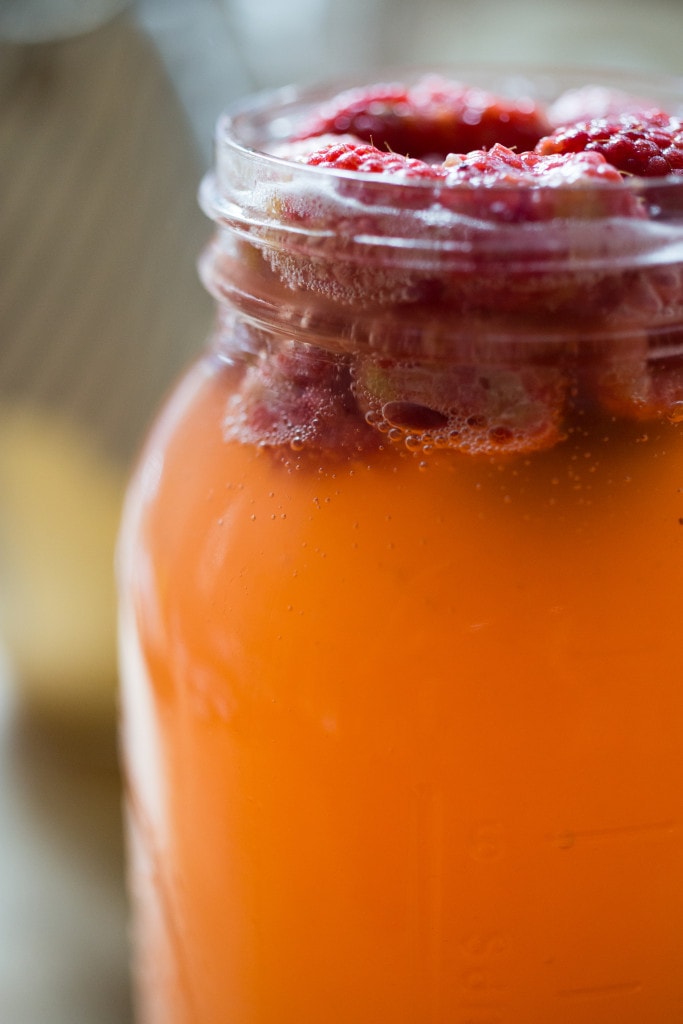
Troubleshooting Water Kefir:
- If you see a white yeast on top of your second ferment, it is most likely kahm yeast. Kahm yeast is harmless but can affect the taste in an unpleasant way.
- If you have Kahm yeast, make sure to rinse your kefir grains in pure clean water before storing in a clean jar with no soap residue. Cover with clean water and feed. This should hopefully prevent it from coming again.
- Make sure to add citrus to your kefir water, to help prevent Kahm yeast.
- Leave less headroom at the top of the jar for oxygen to get in, during the second fermentation (1/2 inch). Rinse your fruit before using, as this can also introduce the yeast.
- Sometimes Kahm yeast can grow when the environment’s temperature is too warm.
- If water kefir is not bubbling or not fermenting, it can be due to a lack of minerals. Use the mineralized sugar mixture, or try adding a pinch of sea salt.
How to Maintain & Grow Your Water Kefir Grains
- The kefir grains that you strained out earlier can be stored in a smaller jar, in the fridge in water or the extra water kefir, you will have after you merge the two jars into one. These grains will need to be fed weekly.
- When refrigerated, you want to feed the grains (with sugar) at least once a week, to keep them healthy and alive. They are happiest when they are actually making water kefir, so I just make one jar a week.
- If you want to make kefir water more often (or grow the grains faster so you can give some away) you can leave them out on the counter, feeding every two days.
- Feed 1 cup kefir grains with 1 tablespoon sugar, in 2 cups water, in the fridge once weekly. Feel free to change out the water every 2-3 weeks.
- The colder they are kept, the slower they will metabolize the sugar. The warmer they are, the faster they will metabolize the sugar- and will need to be fed more often.
- You can tell if the grains are “hungry” by tasting the liquid- if it is not sweet, but tangier, they are probably ready to be fed. If the water is sweet, they are not hungry and do not need to be fed.
- If the sugary water never gets tangy or sour (indicating fermentation) then your grains may likely not be alive or active.
Water kefir Flavors and Variations
Once you get the hang of making water kefir- the variations are truly endless! I usually start with what is in season- seasonal fruits and berries and add from there. You can also add herbs, spices and even chia seeds!
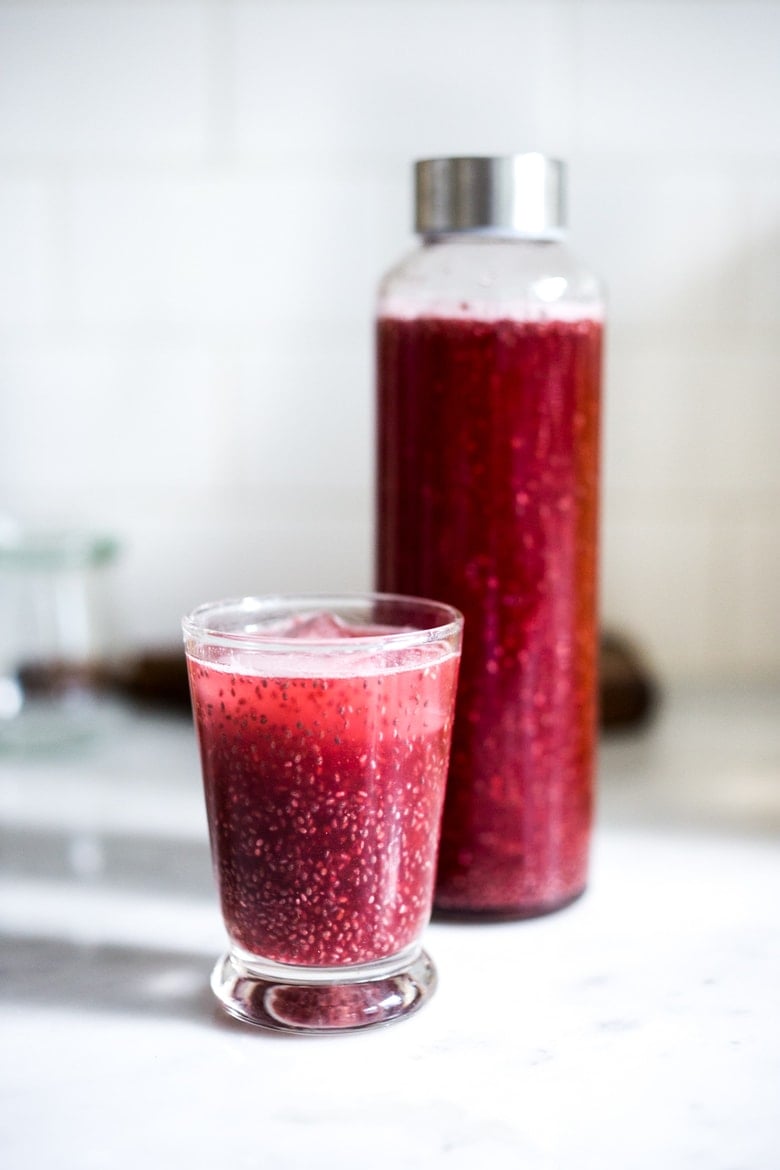
There are so many versions to make….. the possibilities are endless! Here above is Strawberry-Raspberry Water Kefir with Chia Seeds– energizing and refreshing!
Here below is peach ginger.
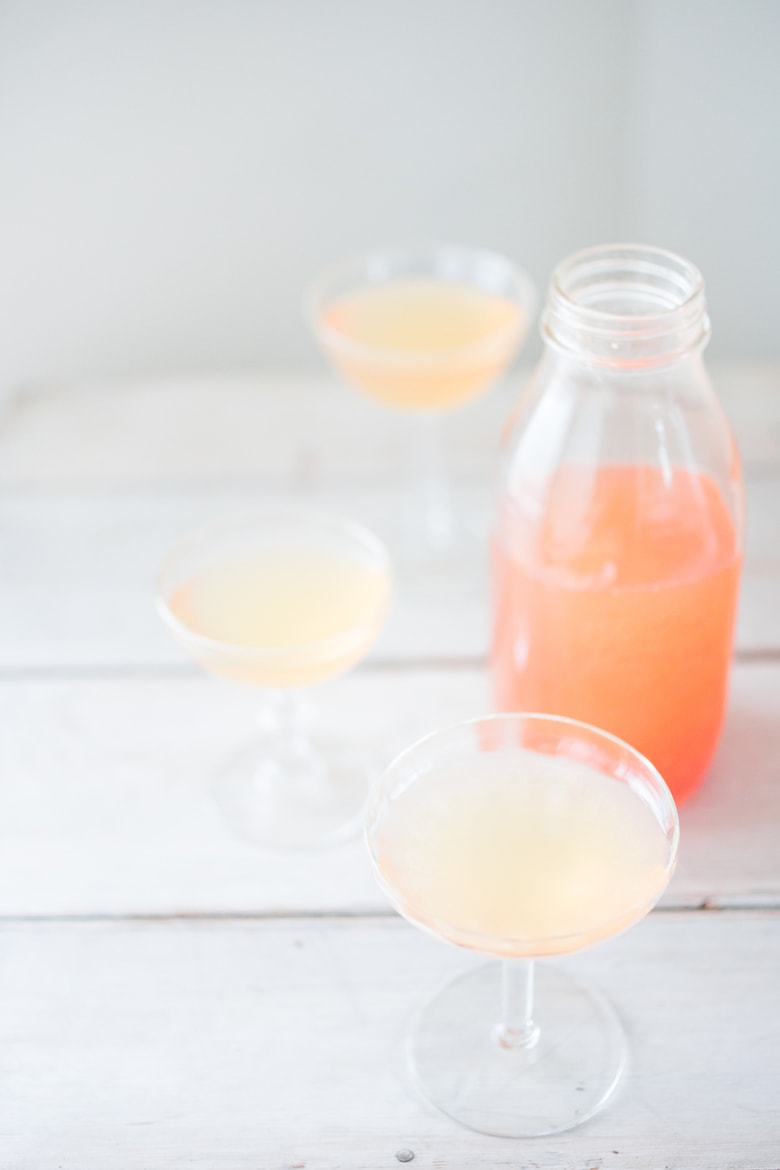
And here below is a Plum-Ginger Water Kefir with shiso leaves.
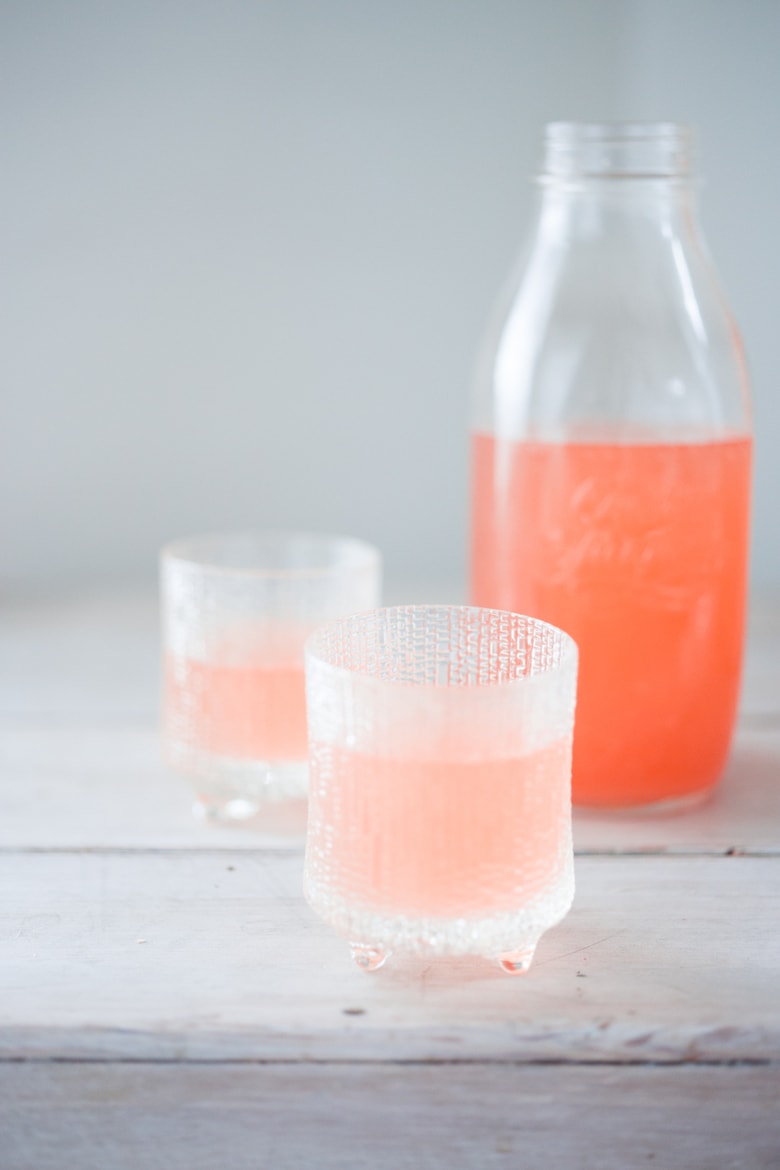
Here is Strawberry Basil Water Kefir!
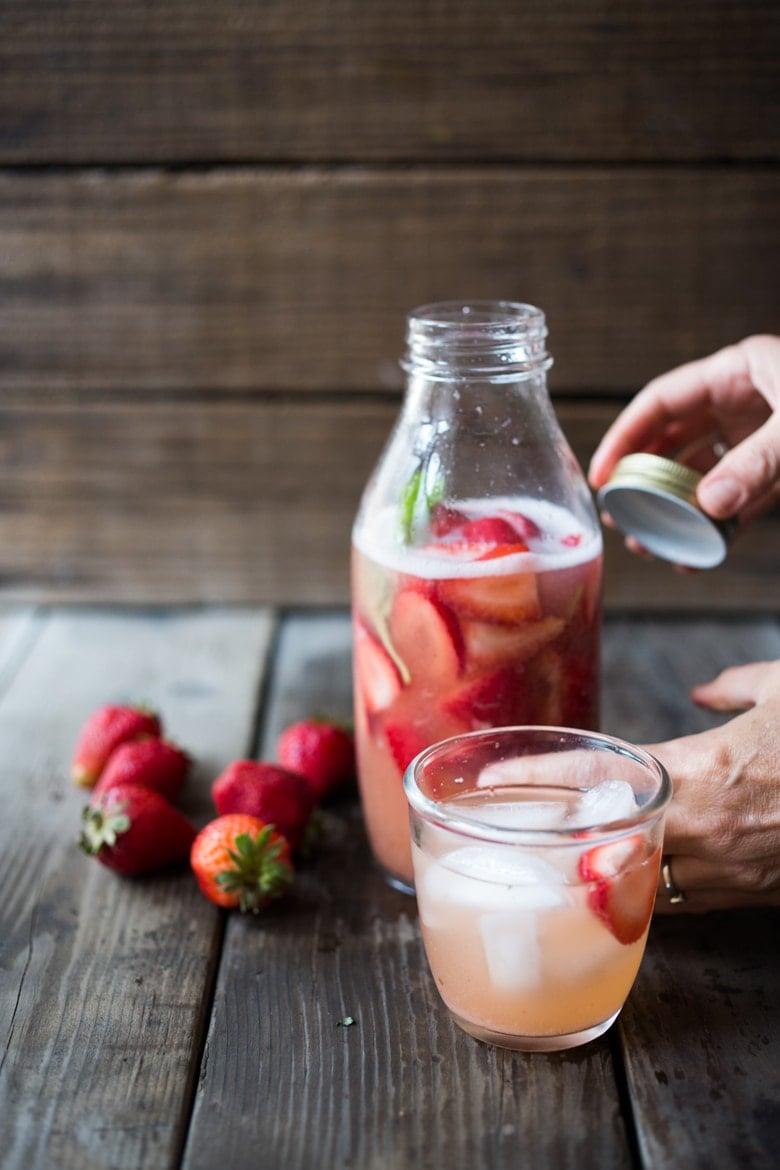
You’ll love how refreshing, tangy, fruity and delicious this is- so much better than a soda stream- with many more minerals, nutrients and probiotics.
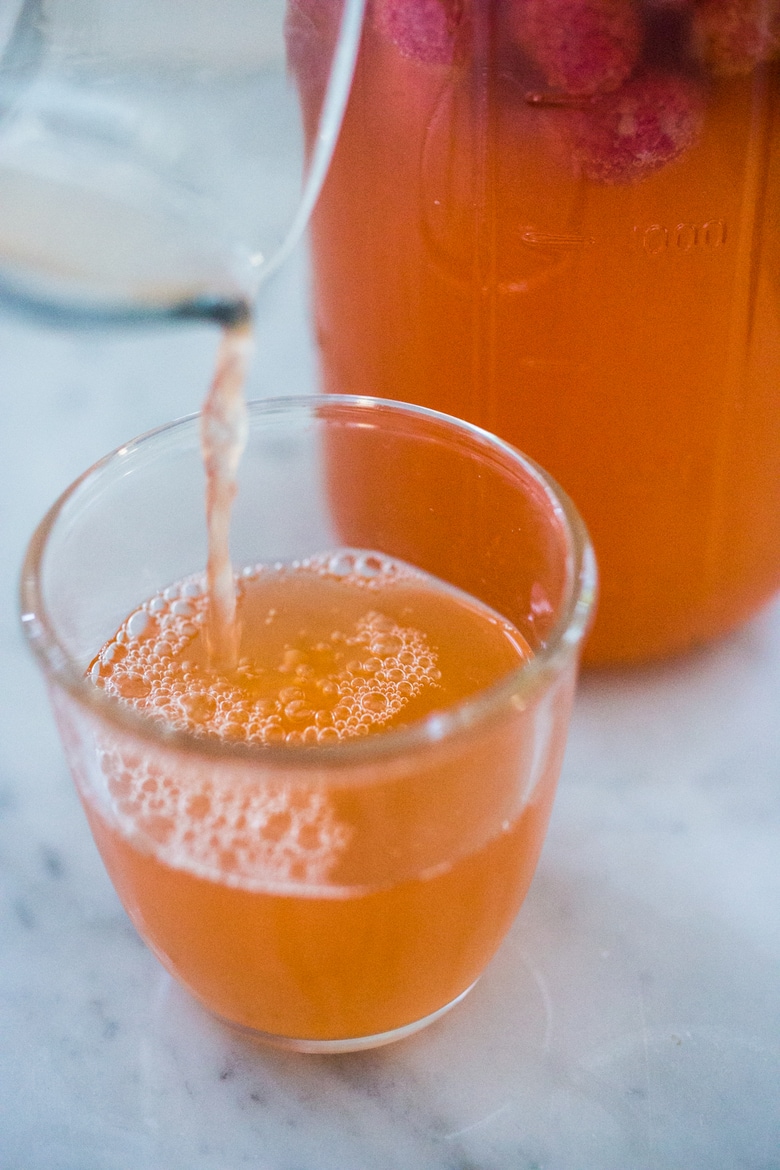
The possibilities are endless! Get some water kefir grains and give it a try!
Health Benefits of Water Kefir
More Fermented Probiotic Recipes
Water Kefir Faqs
Water kefir is full of healthy probiotics that increase the diversity of good bacteria in our gut, the foundation of a healthy immune system. It’s low in sugar, and full of nutrients from fresh fruit.
Water kefir is slightly fermented which can produce trace amounts of naturally occurring alcohol. This is typically around .02 % which equates to roughly ¼ teaspoon in a 12-ounce glass.
If your gut is healthy and diverse, yes! If you are new to consuming fermented foods, or have gut dysbiosis you may need to start off slowly and gently introduce it. Start with a few sips, and see how it feels, if ok, then try a quarter cup, see how you feel, and add from there. If you experience a lot of gas, bloating, back way down, and just take a sip or two daily until these symptoms go away.
Both kombucha and water kefir have health benefits- both contain healthy strains of probiotics. Kombucha contains caffeine from tea and aids with digestion. Water kefir is caffeine-free and typically contains more strains of good bacteria, though some believe not as potent- which may be beneficial for those new to consuming fermented foods- because they are gentler on the belly.
Enjoy the process and please share your flavors and adaptions in the comments below. ❤️
More from Feasting at Home
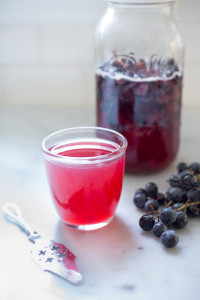
How to make Water Kefir
- Prep Time: 5 mins
- Cook Time: 72 hours
- Total Time: 72 hours 5 mins
- Yield: 8 cups
- Category: Drinks
- Method: fermented
- Cuisine: American
Description
A simple guide to making Water Kefir-a refreshing probiotic fruit-infused drink made with water kefir grains (cactus grains) that is bubbly, effervescent and so healthy!
Ingredients
- 1/2 cup alive water kefir grains
- 8 cups tap or well water- divided
- 1/2 cup sugar (divided) organic cane sugar, coconut sugar, or a ***mixture-see notes. ( FYI this will be metabolized or consumed by the kefir grains, so it will NOT end up in the finished drink!)
- 2 lemon wedges (optional)
- 2 prunes (or dates, or or dried fruit) optional
- ——-
- 1 –2 cups fresh fruit- berries, stonefruit (peaches, plums, nectarines), apples, pears, mango, pineapple, etc.
Optional Additions- fresh ginger, whole spices, herbs.
Instructions
- Fill two, half-gallon mason jars with 4 cups cool tap water in each.
- Add ¼ cup sugar in each, stirring to mostly dissolve. ( Feel free to make sugar mixture first)
- Add ¼ cup kefir grains to each jar.
- Add ¼ cup kefir water to each jar (optional–you can obviously only do this after your first batch of kefir, so just leave it out for the first batch.)
- Add ¼ of a lemon wedge to each jar.
- Add 1 prune to each jar.
- Cover both jars with a thin kitchen cloth and leave on the counter for 2-4 days. 2 days if warm out, 3-4 days if cold. This 2-4 day time period allows the grains “to eat” the sugar, so most of the sugar will actually be metabolized, and not end up in the drink itself. You want the water to get the point where it is just slightly sweet, and nicely tangy. So taste it before moving to the next step. If it tastes very sweet, it’s not ready. When it’s cold this takes longer.
- After 2-3 days the kefir will have fermented slightly, taste tangy or lightly sour, but there is one more step which gives it flavor and makes it effervescent and bubbly.
- FLAVOR: Get your third jar ready and place 1- 1 1/2 cups fresh, ripe fruit in it– like fresh berries, peaches, mango, pineapple, plums, concord grapes, apples, pears – I muddle them up a bit to release their juices. Add a few thin slices of ginger, or whole spices if you wish. Or add 1 cup fruit juice – especially nice in winter when fresh fruit is limited.
- Strain both jars of the fermenting kefir water into the third clean jar with the fresh fruit in it, straining out the kefir grains ( set them aside), tossing the lemon and prunes, filling the clean jar (with the fruit in it) to a 1/2 inch from the top. Then cover tightly with a lid, and leave this on the counter another 24 hours, allowing pressure to build up yet, burping the lids (releasing the pressure), every 8-12 hours or so, more often especially if warm. Keep in mind, not burping may cause the jar to explode. If you must leave them for longer, either loosen the lid and place jar in a bowl to collect runoff, or place the jar in the fridge, to slow the fermentation down, and continue fermenting on the counter when you have more time.
- WARNING: These metal lids like in the photos above, have pros and cons. They allow pressure to build up, with their tight seal, creating bubbly effervescent kefir, but they can explode if the pressure is not released occasionally. Plastic lids are “self-burping”, which if you are away from home for over 8 hours, I would recommend using. The downside is the plastic lids do not let the pressure build quite enough in my opinion so kefir is not quite as bubbly. Sometimes I switch between both, depending on if I am planning to be gone.
- To reiterate- During the 2nd fermentation phase, the water kefir is creating gas and building pressure, which you want it to do – this makes it nice and bubbly, but with the metal lids, you must let out some of the pressure, “burping it” every 6-12 hours or so, so the lid doesn’t bend or blast open (yes this happened to me). With a plastic lid, it stays on fine, it self burps, but it’s less bubbly.
- After 24 hours, the fruit will float to the surface and it’s time to refrigerate it. Burp it, place it in the fridge, lid tight. Once it’s chilled, give it a try. You can strain this and put it in a different pourable container, or just strain as you pour, leaving the fruit in for maximum infusion. Up to you.
- The kefir grains that you strained out earlier should be stored in a smaller jar, in the extra kefir water you will have after you merge the two jars into one. You can refrigerate them and feed with a tablespoon of sugar, every week –or if trying to grow more grains to give away, store the jar on the counter, feeding every couple of days. They grow faster at room temp, and grow slower in the fridge. They are happiest when they are actually making water kefir, so I usually make a jar a week. See notes.
Notes
Sugar Mixture: (optional, but highly nutritious to you kefir grains)
- 1 cup cane sugar
- 1/2 cup coconut sugar
- 1/4 teaspoon sea salt
Yes, feel free to halve the recipe.
It is OK to use frozen berries or fruit.
YES, you can get by with two 2-quart mason jars ( instead of 3). Strain one of the kefir jars into a pitcher, temporarily, rinse out the mason jar, add the fruit to this one, and pour in strained kefir water form pitcher and 2nd jar. Get it? 😉
Adding the lemon helps prevents kahm yeast, and the prune really adds flavor and helps with fermentation.
Kahm Yeast: If you see a white yeast on top of your second ferment, it is most likely kahm yeast. It’s harmless but can affect the taste. If you have Kahm yeast, make sure to rinse your kefir grains in pure clean water before storing in a clean jar with no soap residue. Cover with clean water and feed. This should hopefully prevent it from coming again. Make sure to add Citrus to your kefir water. Make sure all jars are clean. Leave less headroom at the top of the jar for oxygen to get in, during the second fermentation. Rinse your fruit before using, this can introduce the yeast. Sometimes it can grow if the environment is too warm.
How to maintain/grow your kefir grains:
The kefir grains that you strained out earlier can be stored in a smaller 8-ounce jar, in the fridge in the extra water kefir you will have after you merge the two jars into one. Add more water to fill and 1 tablespoon sugar.
- When refrigerated, you want to feed the grains at least once a week, to keep them healthy and alive. They are happiest when they are actually making water kefir, so I just make one jar a week.
- If you want to make kefir water more often (or grow the grains faster so you can give some away) you can leave them out on the counter, feeding every two days.
- Feed 1 cup kefir grains with 1 tablespoon sugar, in 2 cups water, in the fridge once weekly. Feel free to change out the water every 2-3 weeks.
- The colder they are kept, the slower they will metabolize the sugar. The warmer they are, the faster they will metabolize the sugar- and will need to be fed more often.
- You can tell if the grains are “hungry” by tasting the liquid- if it is not sweet, but tangier, they are probably ready to be fed. If the water is sweet, they are not hungry and do not need to be fed.
Nutrition
- Serving Size: 1 cup
- Calories: 38
- Sugar: 8.5 g
- Sodium: 9.7 mg
- Fat: 0.1 g
- Saturated Fat: 0 g
- Carbohydrates: 9.7 g
- Fiber: 1 g
- Protein: 0.2 g
- Cholesterol: 0 mg
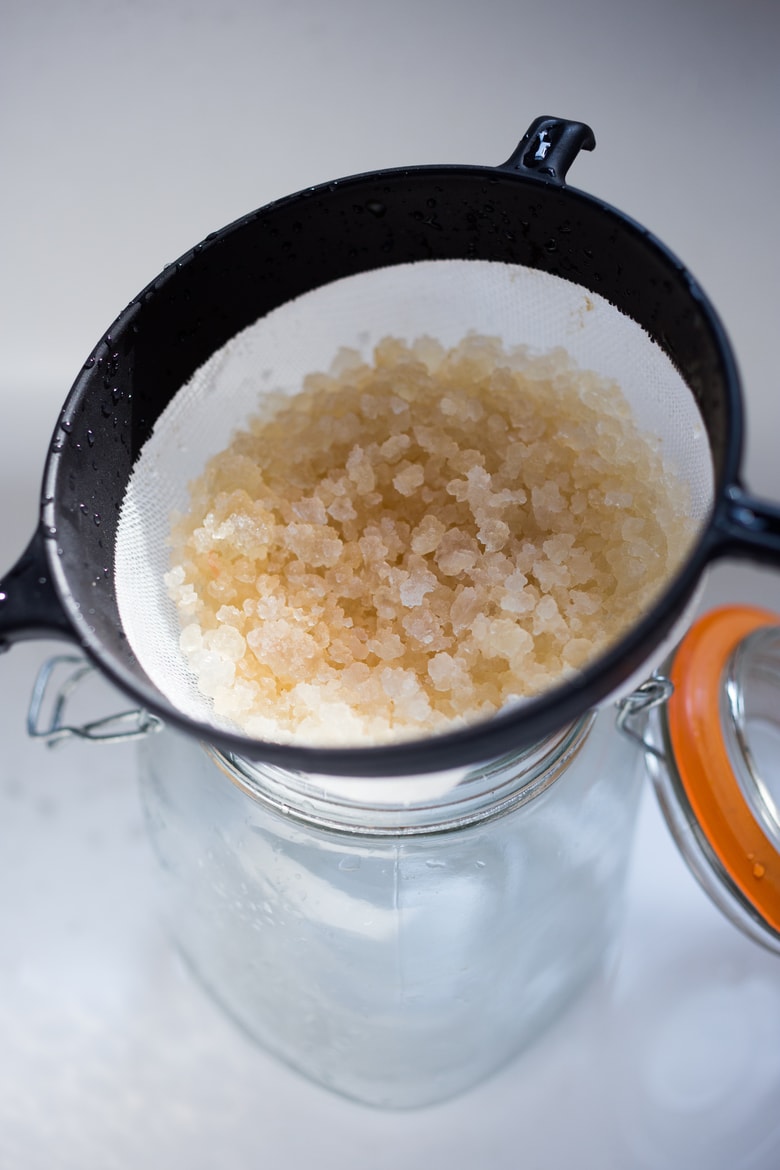
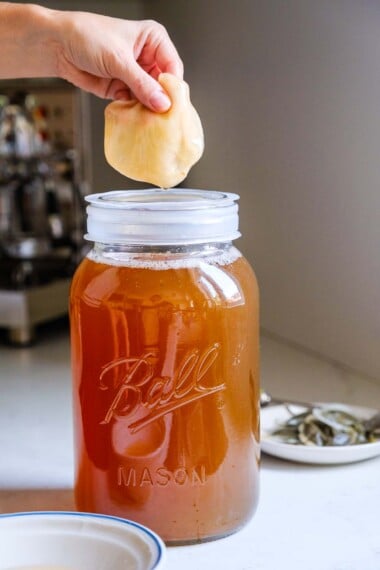
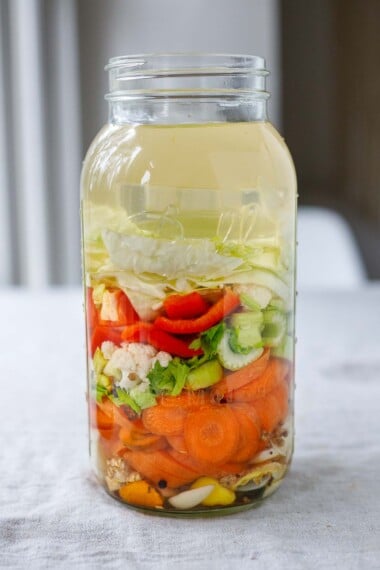
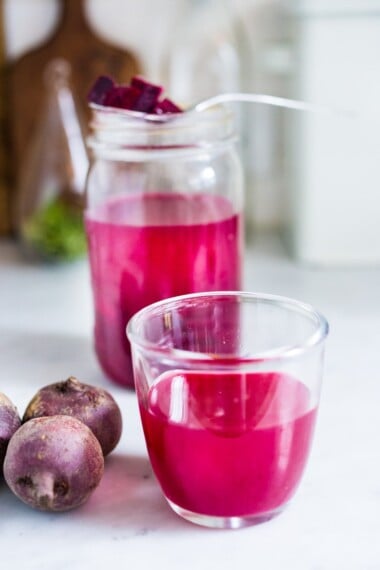
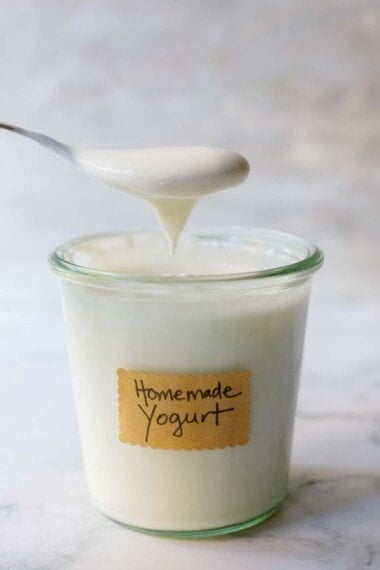
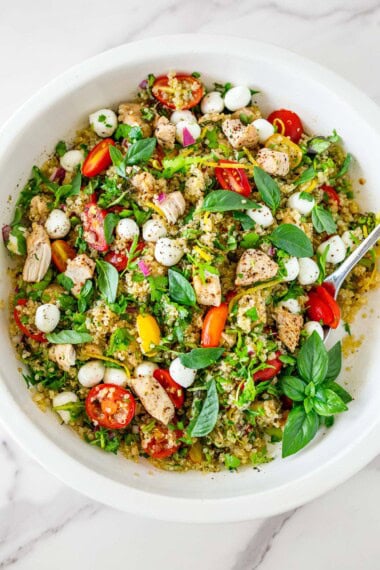

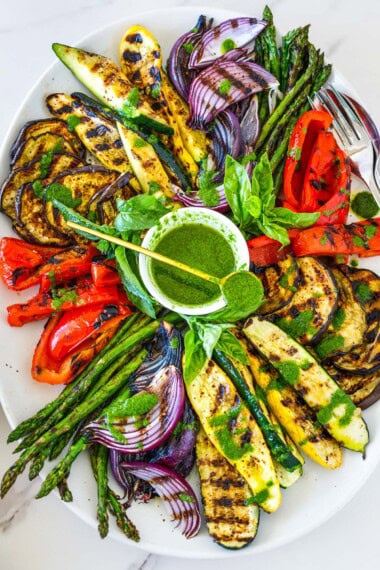



foolproof method to make delicious water kefir!! thank you!
Glad this is working for you Alida!
If I see kahm yeast in my first fermentation, should I remove it when I see it? Remove before I do my second fermentation? Or just leave it alone?
Thanks!
Hey Michelle, you added the lemon slice? Does the kahm yeast look “removeable” to you? Kahn yeast is usually just cloudiness, so I want to be sure this is what you are truly seeing.
Thanks for the reply! Yes, I did add the lemon slices. It’s a cloudy, white substance. I wonder if maybe it’s because I forgot to do the prep for the grains?
Hummm. I am not sure. If is is cloudy but not something you can strain out- then it is probably Kahm yeast. If it is solid in any way, then it may be something else.
Hello,
I’m getting ready to make my first batch of water kefir. I purchased grains from Florida Sun via Amazon and their directions call for adding 1 tablespoon of unsulphered molasses with the sugar and water. Would the molasses replace the prune mentioned in your recipe?
Also, when you mention that you are now making your batch in one jar and not two, do you double your ingredients for one jar to 1/2 cup of grains and 1/2 cup sugar and double amount of water?
Hi Sonya, yes, double everything using one 8-cup jar. I think the molasses is a great sub for the prune!
Thank you for the reply!
Hello! Looks so fun but I’m not clear on why you need 2 jars half full in the first place if you just merge them later- why can’t you just put all your kefir and water in one jar?
Hi Shar, yes probably! This is just the way I learned. 🙂
I’ve never made water kefir. I’m confused on what to do with the kefir grains after you make a batch because on here I read two different things:
“You can refrigerate them and feed with a tablespoon of sugar, every week”
“Feed 1 cup kefir grains with 1 tablespoon sugar, in 2 cups water, in the fridge once weekly. Feel free to change out the water every 2-3 weeks.”
I need clarification when you have a minute!
Hi Jessie, you basically want to keep them happy and fed in the fridge, so you can make more batches. Store the grains in the fridge in ample water to cover them, feeding them weekly with 1 tablespoon sugar. You can strain and change out the water if you like, or just add the sugar. So if you have ½ cup of grains, you could store them in a 4 cup mason jar, cover the grains with 2-3 cups water, and add a tablespoon of sugar. In a week, they will have “eaten” the sugar, so feed them again, adding another tablespoon of sugar. Does this make sense. The amount of water doesn’t really matter, but I usually strain the grains, once a month or so and fill with fresh water.
Yes thanks for clearing that up! I have a new question… so I bought kefir grains on Wednesday and followed the instructions for activating them. They’ve been on my kitchen counter in the sugar water since Wednesday and it is Sunday now and they are still not plump and translucent. Should I do anything to the jar of sugar water since it’s now been 4 days or will they eventually activate?
Hi Jessica! If you are comfortable (this is what I would do) I would taste a teaspoon of the water to see if it still tastes sweet- or if there is any tang to it? Tang indicates the grains are processing the sugar.
So there is no tang only sweetness.
So that means it probably isn’t fermenting- maybe the grains are no longer alive?
I have kefir starter (powder) not grains , will that work instead of grains?
I believe that is for Milk kefir Burt! A completely different thing, but also delicious!
thanks!
I’m about to embark on a kefir water journey. We get our water from the Mississippi River and it contains fluoride. Would leaving the water out for a couple of days be enough time to evaporate the fluoride or using a jug of mineral water from the store be the solution? Your recipe sounds delicious and I’m excited to try it!
Some people say leaving the water out works… but personally I would use mineral water!
Hello! Could raw honey be used as the sweetener?
Honey is not recommended as it has its own bacteria that can compete with the kefir grains.
Hello
I make my kefir every day straining the grains refilling with filtered water raisins demara sugar lemon and a dry fig.sometimes it is bitter.why?
Thank you
Hi Mina, I wonder if it comes from the lemon peel? Do you ever infuse the kekir with other fruit after straining? Or even fruit juice may help.
Really good!
Hi thank you for the recipe. Can you use frozen fruit? Thanks 🙏
Yes, frozen fruit works!
Thank you for such a lovely recipe and instructions. I’m enjoying my water kefir.
If I make the sugar mixture listed in the notes, would I only use a 1/4 cup of that mixture per batch of kefir?
Thanks Kelli, glad you are enjoying! Yes, ¼ cup of total sugar.
enjoying this recipe.
This is so confusing to me.
Do I have to use fruit, will the fruity water be as sparkling as kombucha?
Can it be just plain water?
Hi Andrea- yes you can make this without infusing it with fruit, the fruit is just for flavor. If you allow the jar to biuld of pressure it can be bubbly like Kombucha, or you can leave the lid loose, no pressure and no bubbles. Up to you.
Great info! How do you feel about using spring water?
Spring water is great!
Why do you do the first ferment in 2 mason jars?
This is how I was taught initially- and honestly lately I’ve been using one jar with good results. 🙂
My water kefir is beautiful – thank you for the great recipe. However, I find it a bit sweeter than I would like and wonder if all the sugar is getting digested. Should I ferment longer? Or use less sugar?
Yes, if it still tastes sweet, ferment longer. The nice thing is you can ferment as long as you like to get as much sugar “digested” as you want. I make mine quite tangy!
Thanks so much! For the second ferment is it possible to use orange juice?
Yes, that should work Heidi. I would try 1 part oj to 3 parts kefir water. Orange soda, yum!
I have been making kombucha for years now, but I read that it is not healthy in larger quantities for children.My kids love it because it is fruity and bubbly (they don’t drink any type of soda or store bought juice), but their dentist asked me to lower their kombucha intake,or drink it through a straw.
I plan on making this instead, as it is healthier and I don’t have to worry about caffeine intake or their teeth.
About the 2nd ferment, can that be done in the 8 oz kombucha bottles? They are very thick, strong bottles with strong plastic lids.If I can, do I still need to burp it every 6 to 12 hours?
Also, when kept in the fridge, do the grains need a lid, and can raisins be used instead of plum, and how many for 1 gallon batch?
Made water kefir for a short while about 15 years ago, but I remember using raisins and unsulphured molasses.I just can’t remember the whole process, but I remember that I stopped after a huge explosion happened, that destroyed the top of my stove.
Thank you.
I think bottling in smaller bottles should be fine if refrigerated, burp ever 2-3 days? Yes, raisins are fine as well as a little molasses.
To grow the kefir grains, do I leave on the counter with a lid, or with a cloth over it?
Either Lenore! A loose lid, or cloth- something that will let air out, but keep fruit flies out.
I started Making kefir a few months ago. Now it is my favorite drink. Healthy, personal and delicious!! The recipe I had was very close to this. This article has many useful tips that I plan to incorporate. Thank you so much!!
It is such a fun process isn’t it! So happy you found this helpful. What are your favorite concoctions?
Thank you for such an informative post! I’m so excited to try this! To keep the kefir grains alive do you use regular water or kefir water from the initial batch? Also where did you get your grains? Thanks!
I use both if possible. Mostly fresh water and any leftover water kefir.
How long will the finished kefir water keep and how should it be stored? Thanks so much for a well spelled out recipe!
It will keep for a couple of weeks in the fridge. Storing in swing-top bottles is the best, they seal tight and prevent explosions and keep it carbonated.
I am not sure that cane sugar is vegan as it is filtered by using bone char. Is it ok to use just coconut sugar?
That is fine Cathy, but it will darken the color a bit. Organic cane sugar is vegan to my knowledge.